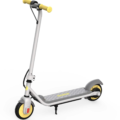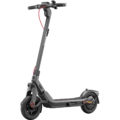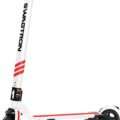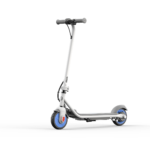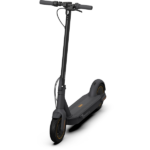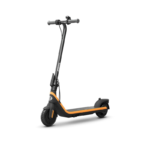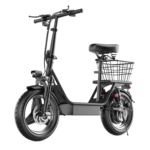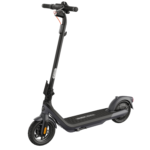- Home
- Scooters
- Electric Scooters
- Segway Ninebot ZING E8
Segway Ninebot ZING E8
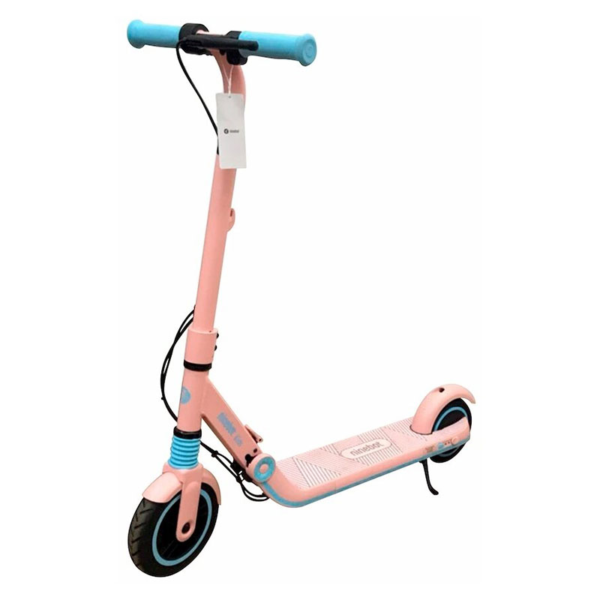



- Battery Range: 10 km (6.2 mi)
- Top Speed: 14 km/h (8.7 mph)
- Motor Power: 200 W (rated/max)
- Weight Capacity: 50 kg (110 lb)
- Charging Time: 4 h
- Scooter Weight: 7.9 kg (17.4 lb)
PROS
- Folds quickly (hands-free pedal)
- Front spring shock absorption
- Solid tyres: no tubes to patch
- Triple brakes incl. EBS/regen
- IPX4 with Smart BMS
CONS
- Short range at full speed
- No rear mechanical drum
- Solid tyres feel firm on cobbles
- No app connectivity
- Not for off-road surfaces

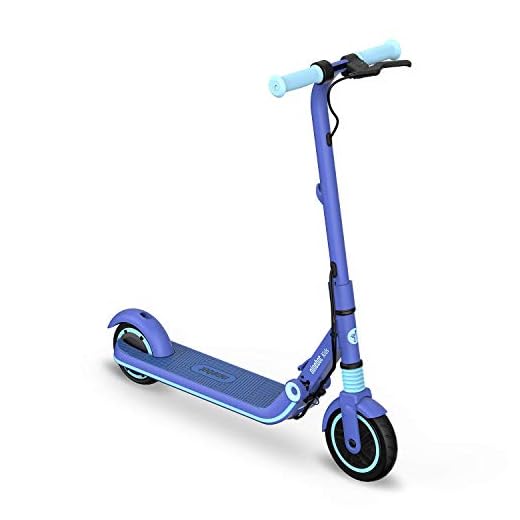
Overview: Lightweight, Foldable Starter Scooter
The Segway Ninebot E8 (ZING E8) is a foldable kids’ eKickScooter built to make first rides safe, simple, and seriously fun. Designed for ages 6–12, it tops out at 14 km/h and delivers up to 10 km of range—numbers that keep excitement high while still respecting early skill levels. Moreover, a front spring shock helps smooth small bumps, while solid rubber tyres eliminate tube flats and keep upkeep refreshingly simple. Because it also folds quickly and weighs just 7.9 kg, the E8 is easy to carry to the car, up the stairs, or into hallway storage.
Furthermore, the E8 layers confidence on top of convenience. Three riding modes guide skill growth, and a triple-brake setup—electronic EBS, rear fender brake, and regenerative assist—teaches predictable stopping from day one. Meanwhile, an IPX4 rating adds basic splash protection for light, real-world drizzle. Consequently, the E8 becomes a friendly introduction to electric scootering for younger riders who are ready to graduate from push scooters yet still need measured speed, simple controls, and clear routines.
Who the ZING E8 Is For (and Why It Fits)
The E8 suits families who want a lightweight, foldable starter scooter that balances safety with fun. Specifically, it’s a great fit for:
- New riders (6–12 yrs) who benefit from gentle speeds and smooth power delivery.
- Parents who prefer puncture-proof tyres, predictable braking, and easy carrying.
- Neighborhood routes like cul-de-sacs, park paths, and school-yard loops.
- Small storage spaces, since the slim frame folds neatly beside a door or under a desk.
Because the E8 emphasizes control over chaos, kids gain confidence quickly. As a result, families ride more often, argue less about prep, and build healthy outdoor habits.
Design Philosophy: Light, Foldable, and Friendly
Everything about the ZING E8’s design supports early success. The deck height is low and welcoming, so mounting and stepping off feel natural. The handlebar reach suits smaller arms, which reduces over-correction and keeps steering calm. In addition, the cockpit remains uncluttered—kids see speed, battery bars, and mode at a glance rather than hunting through buttons.
Crucially, the folding mechanism is fast and intuitive. With a simple motion, the 7.9 kg chassis compacts for car boots, stair carries, and hallway nooks. Because the latch feels positive and secure, adults trust the fold, and kids learn to wait for the “click” before they roll. Consequently, the E8 transitions smoothly between home, school, and park without slowing the day down.
Motor & Speed: Smooth Power That Teaches Good Habits
On a kids’ scooter, how power arrives matters more than sheer wattage. The E8’s brushless drive is tuned for progressive launches and steady cruising up to 14 km/h. Therefore, first accelerations feel predictable rather than jerky. As riders relax their elbows and keep eyes up, their balance improves naturally.
Additionally, the thumb throttle has a gentle, readable throw. Small inputs create small speed changes, which teaches control and patience. Because kids connect cause and effect early, they carry those good habits into every ride thereafter.
Three Riding Modes: Grow Skills, Step by Step
Learning sticks when progress is structured. Accordingly, the E8 offers three modes that parents can select as confidence rises:
- Safe Mode: Reduced acceleration and capped top speed for day-one fundamentals—mounting, coasting, and smooth stopping.
- Cruise Mode: Balanced throttle response for everyday laps on clean paths; great for building rhythm and endurance.
- Turbo Mode: The snappiest mapping within the 14 km/h cap for confident riders who have mastered smooth starts and tidy stops.
Because mode changes are quick, adults can start cautious and gently unlock more as demonstrated skill increases. Consequently, excitement grows in parallel with control.
Brakes: Triple System for Predictable Stopping
Stopping should feel calm, repeatable, and intuitive. The E8’s triple-brake system delivers exactly that:
- Electronic EBS gently slows the wheel with smooth, computer-controlled deceleration.
- Rear fender brake adds familiar, foot-activated control for quick adjustments.
- Regenerative assist helps scrub speed on gentle downhills while recapturing a bit of energy.
Together, these systems build modulation skills rather than panic grabs. To reinforce the habit, begin each session with a 20-second drill: roll at walking pace, squeeze the lever smoothly, then finish with a clean fender-brake stop. Because it feels like a mini-game, kids love it—and their stopping becomes impressively polished.
Ride Comfort: Front Spring Shock + Solid Tyres
Comfort feeds confidence. The E8’s front spring shock filters out driveway cracks, brick seams, and small expansion joints. Meanwhile, solid rubber tyres remove tubes (and thus punctures) from the equation. Although solid tyres transmit a bit more texture than air-filled ones, the E8’s measured speed and front suspension keep the overall ride friendly.
To smooth things further, coach three simple cues:
- Keep a gentle knee bend to absorb bumps.
- Scan ahead and pick straight, clean lines.
- Roll over small cracks rather than swerving at the last second.
Because kids master these micro-skills quickly, rides feel calmer almost immediately.
Battery, Range & Charging: Simple and Predictable
With up to 10 km of range in favorable conditions, the E8 easily covers short school hops and weekend park loops. Moreover, the charging routine is straightforward; families typically plug in after school or before bedtime and start the next outing with a full battery.
Parent-friendly battery care tips:
- Try to stay above ~20% for day-to-day use; avoid frequent deep discharges.
- If pausing riding for weeks, store around half charge.
- Charge and store indoors away from temperature extremes.
- Power the scooter off after rides to minimize idle drain.
Consequently, range remains consistent, and the battery stays healthy month after month.
Fit & Ergonomics: Sized for 6–12 Without the Guesswork
Proper fit makes control easier. When a rider stands tall on the deck, the handlebars should land around mid-chest height with slight elbow bend. If arms lock straight, raise the stance or adjust posture; if elbows crowd the body, encourage a wider, relaxed grip. Additionally, teach the classic staggered stance—front foot angled, rear foot slightly offset—which squares the hips and steadies the torso. Because these tweaks only take a minute, the payoff in control is huge.
Weather Readiness: IPX4 Splash Protection (With Limits)
Life doesn’t stop for a sprinkle, and neither should short rides. Thanks to IPX4, the E8 tolerates light rain and casual splashes. Nevertheless, set clear limits:
- Avoid heavy downpours and standing water.
- Brake earlier on wet surfaces and keep the scooter upright during stops.
- Wipe the deck, controls, and brake areas after damp sessions.
- Store indoors so everything dries fully.
As a result, the scooter stays reliable across shoulder seasons without inviting avoidable wear.
Storage & Transport: Quick Fold, Easy Carry
Because the E8 weighs only 7.9 kg, adults can lift it with one hand, and kids can help with doors or small steps. The fast fold simplifies transitions between locations:
- Car boot: Lay it flat, latch secured, and strap lightly if sharing the trunk.
- Stairs: Adults carry; kids clear the path—teamwork keeps it safe.
- Hallways: Park nose-out near your “scooter station” for quick departures.
Consequently, the E8 never feels like a burden; it just fits the day.
Safety Setup: Make Good Habits Automatic
A short, repeatable routine turns safety into muscle memory:
- Helmet on, straps snug (two fingers under the chin).
- Closed-toe shoes—no sandals or dangling laces.
- Brake test at walking pace.
- Light rain check—if surfaces gleam, slow early and ride straight.
- Rules recap—ride right, pass politely, and never weave through crowds.
Because the checklist takes less than a minute, kids soon lead it themselves.
Four-Week Learning Plan (Kids Think It’s a Game)
Week 1 — Starts & Stops (Safe Mode):
Empty court, smooth surface. Practice mounting, push-offs, and “silent stops” (no squeaks, no skids). Celebrate three perfect stops.
Week 2 — Smooth Steering (Safe → Cruise):
Chalk wide S-turns; emphasize eyes up and elbows soft. Add gentle speed only after lines look clean.
Week 3 — Real Routes (Cruise):
Move to a quiet loop. Teach single-file riding, scanning ahead, and polite passing. Introduce short Turbo segments if control remains steady.
Week 4 — Routines & Responsibility (Cruise → Turbo):
Kids announce the safety checklist; parents set a landmark goal and a battery buffer. Finish with a “best line” challenge through the chalk course.
Because progress is visible and fun, confidence rises without rushing.
Skill-Building Mini-Games (That Sneak in Training)
- Smooth Start Challenge: Three launches with zero wobble.
- Cone Slalom: Wide spacing, calm turns, no throttle spikes.
- Glow-Line Cruise: Follow a chalk line at steady speed with relaxed elbows.
- Stop on the Dot: Brake to halt with the front wheel on a chalk circle.
Consequently, practice feels like play—and kids ask to ride again.
Maintenance: Low Effort, High Confidence
The E8 is deliberately maintenance-light. Solid tyres banish flats; enclosed components resist everyday grit. Still, a tiny routine pays off:
- Weekly: Wipe the deck and reflectors; glance at bolts on stem/axles; test the fold latch.
- Monthly: Check brake feel and cable condition; inspect tyres for cuts.
- Quarterly: Clean the charging port/cap; do a slow fastener check.
- Seasonally: Review overall condition; refresh any manufacturer-recommended consumables.
Because upkeep is short and simple, more time goes to riding, not repairing.
Seasonal Tips: Ride More Days, Safely
- Spring: Grit lingers—extend braking distances and wipe dust afterward.
- Summer: Heat tires out small hands—ride early or late and let the scooter cool before charging.
- Autumn: Wet leaves are slick—brake early and keep lines straight.
- Winter: If riding is allowed, keep sessions short, avoid ice, and store indoors. When gloves feel too thin for consistent braking, postpone the ride.
Therefore, kids learn to read conditions as part of riding well.
Parent FAQs
Is 14 km/h enough to be fun?
Yes. At kid scale, 14 km/h feels lively while remaining manageable. Plus, it supports calmer learning and shorter stopping distances.
How far will we actually get?
Up to 10 km in friendly conditions. Hills, cold temps, and frequent stops reduce range; therefore, plan out-and-back routes with a margin.
Can my child ride in the rain?
Light sprinkles are fine under IPX4. Even so, avoid heavy rain and puddles, brake earlier, and wipe the scooter dry afterward.
Does the E8 climb hills?
It handles gentle neighborhood inclines best. On steeper grades, expect slower speeds or use a push assist.
Is folding sturdy enough for daily use?
Yes—provided you latch fully until it clicks. Because the mechanism is simple and solid, it’s well-suited to daily folds.
Do we need special tools?
No. A basic multi-tool and a clean cloth cover routine checks. For anything unusual, follow the manufacturer’s guidance.
When the E8 Might Not Be Ideal
Clarity helps everyone. The E8 may not fit riders who need:
- Higher top speeds for older teens,
- Long-distance range beyond neighborhood use, or
- Off-road capability with larger pneumatic tyres and suspension.
If those needs sound familiar, consider stepping up within the ZING range or moving to an entry-level adult scooter. Otherwise, the E8’s balance of light weight, folding convenience, and sensible speed is exactly the point.
Final Verdict: Lightweight, Foldable Confidence for First Rides
The Segway Ninebot E8 (ZING E8) is a lightweight, foldable starter scooter that turns early practice into real-world confidence. It cruises up to 14 km/h, travels up to 10 km per charge, and smooths small bumps with a front spring shock. It also avoids flats with solid rubber tyres and builds braking skill through a triple-system (electronic EBS, rear fender, and regenerative assist). Because it weighs 7.9 kg, folds fast, and carries IPX4 splash protection, it fits busy family life as easily as it fits small riders.
If you want a friendly, foldable first eKickScooter that teaches good habits, keeps maintenance low, and stays fun ride after ride, the ZING E8 is an easy recommendation.
Specifications
General
| Model The Model specifies the exact version or name of the scooter. It helps identify its unique design, features, and specifications within the manufacturer’s product line. Knowing the model makes it easier to compare options, find compatible accessories, or look up support information. | Ninebot ZING E8 |
| Brand The Brand identifies the manufacturer or company that designs and produces the scooter. A trusted brand is a sign of quality, reliability, and good customer support. Well-known brands often have higher standards for safety, performance, and after-sales service, giving you more confidence in your purchase. | Segway |
| Release Date The Release Date indicates when the scooter model was officially launched on the market. This helps you know how current the design, technology, and features are. A newer release date often means updated components, improved performance, and the latest safety or smart features. | 17 November 2025 |
| Recommended Age Recommended Age indicates the minimum age range that the scooter is designed for, based on safety, size, and ease of use. Following the recommended age helps ensure that riders can handle the scooter’s speed, weight, and controls comfortably and safely. Always check local laws and use protective gear, especially for younger riders. | Appropriate age 6–12 |
Performance & Power
| Motor Power (Wattage) What it means: The motor power, measured in watts (W), shows how strong the scooter’s electric motor is. Why it matters: Higher wattage usually means better acceleration, more torque, and improved performance on hills or rough terrain. For example, a 250W motor is good for flat city roads and light riders, while a 500W or 1000W motor provides more power for faster speeds or climbing steep inclines. | 200 W |
| Top Speed The Top Speed indicates the maximum speed that the scooter can reach under optimal conditions. It’s usually measured on level ground with a fully charged battery and an average rider weight. A higher top speed allows you to travel longer distances faster, but always ensure you ride within legal speed limits and your personal comfort zone for safety. | 14 km/h (8.7 mph) |
| Battery Capacity Battery Capacity refers to the total amount of energy the scooter’s battery can store, usually measured in ampere-hours (Ah) or watt-hours (Wh). A higher battery capacity means you can ride longer distances on a single charge, reducing the need for frequent recharging. Keep in mind that actual range can vary depending on rider weight, terrain, speed, and weather conditions. | 55.08 Wh (21.6 V) |
| Estimated Range per Charge The Estimated Range per Charge indicates the average distance the scooter can travel on a single full battery charge. This range is calculated under optimal conditions, such as flat terrain, moderate speed, and average rider weight. Real-world range may vary depending on riding style, terrain, weather, and load. A longer range means fewer recharges and greater freedom for longer trips. | Up to 10 km (6.2 mi) |
| Hill Climb Ability Hill Climb Ability describes the maximum incline or slope that the scooter can handle while maintaining stable performance. It’s typically expressed as a percentage or in degrees. A higher hill climb rating means the scooter can tackle steeper hills without losing too much speed or power. Actual climbing performance may vary based on rider weight, battery charge, and terrain conditions. | — |
| Drive System The Drive System refers to how power from the motor is delivered to the wheels. Electric scooters typically use either a hub motor (directly integrated into the wheel) or a chain/belt drive system. A high-quality drive system ensures smooth acceleration, efficient power transfer, and low maintenance. The choice of drive system affects performance, noise level, and overall ride experience. | Front hub drive (FWD) |
Charging & Electrical
| Charging Time Charging Time indicates how long it takes to fully recharge the scooter’s battery from empty to 100% using the standard charger provided. Faster charging means less downtime and more time on the road. Actual charging time may vary slightly depending on battery capacity, charger output, and environmental conditions. | Approx. 4 hours |
| Battery Type Battery Type refers to the specific technology used in the scooter’s battery, which affects performance, lifespan, weight, and charging time. Most modern electric scooters use high-quality lithium-ion (Li-ion) batteries because they offer a good balance of energy density, durability, and low maintenance. A reliable battery type ensures consistent power delivery and longer riding ranges. | Li-ion with Smart BMS |
| Removable Battery A Removable Battery means the battery pack can be easily detached from the scooter for convenient charging and replacement. This feature allows you to charge the battery separately, swap it with a spare for extended range, or securely store it indoors in extreme weather. Removable batteries add flexibility and make it easier to keep your scooter powered up wherever you are. | No external fast charge |
| Regenerative Braking Regenerative Braking is an energy-saving feature that converts some of the energy normally lost during braking back into battery power. When you slow down or brake, the motor works in reverse to generate electricity, which helps extend the scooter’s range and improves overall efficiency. This system also reduces wear on traditional brake components, leading to lower maintenance over time. | Regenerative electronic assist |
| Lighting Lighting refers to the built-in front and rear lights that enhance visibility and safety when riding in low-light conditions or at night. Good lighting helps you see the road ahead and ensures that other road users can see you. Many scooters include LED headlights, taillights, and sometimes brake lights or side reflectors for added safety and compliance with local traffic regulations. | Battery indicator LEDs (no brake light) |
Build & Dimensions
| Scooter Weight Scooter Weight refers to the total weight of the scooter when fully assembled, including the battery. This affects how easy it is to carry, lift, and store the scooter when not in use. A lighter scooter is more portable and convenient for commuting, especially if you need to carry it upstairs or onto public transport. Keep in mind that a sturdy frame and quality components may add to the weight but also contribute to better durability and ride stability. | 7.9 kg (17.4 lb) |
| Maximum Rider Weight Maximum Rider Weight indicates the highest rider weight that the scooter is designed to safely support while maintaining optimal performance and stability. Staying within this limit helps ensure reliable acceleration, braking, and climbing ability, and it protects the frame, suspension, and motor from excessive strain. Exceeding the recommended limit may reduce performance and increase wear on components. | 50 kg (110 lb) |
| Deck Size Deck Size refers to the dimensions of the scooter’s standing platform. A wider and longer deck provides more foot space, allowing you to stand comfortably and adjust your stance while riding. A well-sized deck improves balance and stability, especially on longer rides or at higher speeds. Compact decks, on the other hand, help keep the scooter lightweight and portable. | Low deck; slim folded profile |
| Handlebar Height Handlebar Height refers to the distance from the deck to the handlebars, which affects your riding posture and comfort. An appropriate handlebar height helps you maintain good balance, reduces strain on your back and arms, and makes steering more comfortable. Some scooters have adjustable handlebars to fit riders of different heights, while others have a fixed height for a streamlined design. | Kid-friendly fixed height |
| Folding Mechanism The Folding Mechanism describes how easily and securely the scooter can be folded for carrying and storage. A well-designed folding system lets you quickly collapse the scooter into a compact size, making it convenient to transport on public transit, store under a desk, or fit into a car trunk. Look for sturdy latches and safety locks to ensure the scooter stays firmly in place when folded or unfolded. | Hands-free quick folding pedal |
| Dimensions Folded Dimensions indicate the size of the scooter when it’s fully folded. This measurement shows how much space the scooter will take up when stored or carried, making it easier to check if it will fit in your car trunk, under a desk, or in a closet. Compact folded dimensions are ideal for commuters who need to bring their scooter on public transport or store it in tight spaces. | 875 × 330 × 320 mm (folded) |
| Material Material refers to the primary construction materials used for the scooter’s frame and key components. High-quality materials like aircraft-grade aluminum, reinforced steel, or durable composites provide strength, stability, and a lighter overall weight. A sturdy material ensures the scooter can handle daily wear and tear while maintaining safety and performance. | Aluminum alloy |
Safety & Control
| Brake Type(s) Brake Type(s) describe the braking systems the scooter uses to help you slow down or stop safely. Common brake types include mechanical brakes (like drum or disc brakes), electronic brakes, and foot brakes. Many scooters combine multiple braking systems for added safety and shorter stopping distances. The type and quality of brakes affect your control, especially when riding at higher speeds or on slopes. | Electronic front + rear fender + regen |
| Suspension Suspension refers to the system that absorbs shocks and vibrations while riding, providing a smoother and more comfortable ride over uneven or rough surfaces. Scooters may have front suspension, rear suspension, or dual suspension for better shock absorption and stability. Good suspension helps reduce rider fatigue and improves control, especially when riding on bumpy roads or off-road paths. | Front spring shock |
| Tire Type Tire Type refers to the kind of tires the scooter uses, which directly affects ride comfort, traction, and maintenance. Common types include solid (airless) tires, pneumatic (air-filled) tires, or hybrid options. Pneumatic tires offer better shock absorption and a smoother ride on rough surfaces, while solid tires are puncture-proof and require less upkeep. The right tire type helps ensure safe handling and a comfortable ride in different conditions. | Solid rubber (maintenance-free) |
| Tire Size Tire Size indicates the diameter and width of the scooter’s tires, which affect ride comfort, stability, and how well the scooter handles different terrains. Larger tires generally offer better shock absorption and a smoother ride over bumps and rough surfaces, while smaller tires keep the scooter lighter and more portable. Choosing the right tire size helps ensure a balance between agility and comfort. | Front 7", Rear 6" |
| Kickstand The Kickstand is a built-in stand that allows you to park your scooter upright when it’s not in use. A sturdy kickstand keeps the scooter stable and prevents it from tipping over, protecting it from scratches and damage. It also makes storing and accessing your scooter more convenient, whether you’re at home, work, or on the go. | Side kickstand |
| Water Resistance Rating Water Resistance Rating indicates how well the scooter is protected against water and moisture, usually shown as an IP (Ingress Protection) rating. This rating helps you understand whether the scooter can handle light rain, splashes, or wet roads without damage. While most scooters are not fully waterproof, a good water resistance rating adds peace of mind when riding in changing weather conditions. Always avoid deep puddles or submerging the scooter to protect its electrical components. | IPX4 body |
Features & Extras
| Display/Console The Display (or Console) shows important real-time information about your ride, helping you monitor your scooter’s status at a glance. Typical displays show speed, battery level, distance traveled, and riding mode. Some models also include additional features like Bluetooth connectivity, app integration, or backlighting for better visibility at night. A clear and easy-to-read display enhances safety and convenience on every trip. | Status LEDs (no full dashboard) |
| Ride Modes Ride Modes refer to the different speed and power settings you can choose to match your riding style or road conditions. Common modes include eco for maximum range and energy efficiency, standard for everyday balance, and sport or turbo for higher speed and stronger acceleration. Switching between ride modes allows you to customize performance, conserve battery, and ride safely in various environments. | Safe, Cruise, Turbo |
| Smart App Connectivity Smart App Connectivity lets you pair your scooter with a dedicated mobile app via Bluetooth. Using the app, you can monitor real-time ride stats like speed, battery level, and range, adjust settings such as ride modes or cruise control, lock the scooter for added security, and sometimes receive firmware updates. This feature adds convenience and allows you to personalize your riding experience right from your smartphone. | No app connectivity |
| Anti-Theft System The Anti-Theft System helps protect your scooter from unauthorized use or theft. This feature can include built-in alarms, electronic motor locks, GPS tracking, or remote locking through a mobile app. A good anti-theft system provides peace of mind when parking your scooter in public spaces, adding an extra layer of security to safeguard your investment. | Triple brakes; kids tutorial decals |
| Cruise Control Cruise Control allows you to maintain a steady speed without continuously holding the throttle. This feature makes longer rides more comfortable by reducing hand fatigue and providing a smoother, more relaxed riding experience — especially on flat, open roads or bike lanes. For safety, cruise control can usually be easily activated or deactivated while riding. | No |
| Accessories Included Accessories Included lists the additional items that come with the scooter to enhance your riding experience and convenience. Common accessories may include a charger, kickstand, bell, lights, phone holder, or carrying strap. These extras add value by making your scooter safer, easier to use, and ready to ride straight out of the box. | Bell (where supplied), charger |
Warranty & Compliance
| Warranty Period The Warranty Period indicates how long the manufacturer guarantees the scooter against defects in materials and workmanship under normal use. A good warranty provides peace of mind, showing the brand’s confidence in its product quality. Always check what parts are covered, such as the frame, battery, and motor, and follow the maintenance guidelines to keep your warranty valid. | Typically 12 months (regional) |
| Certifications Certifications confirm that the scooter meets specific safety, quality, and environmental standards set by recognized organizations or regulatory bodies. Common certifications may include CE, RoHS, UL, or other local compliance marks, depending on your region. These certifications ensure that the scooter is manufactured to high standards and is safe and legal to use in your country. | Local kids eKickScooter compliance |
Price Comparison




